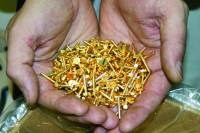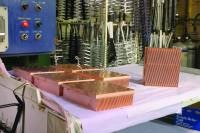Process- Focused
Training, industry certification boost aerospace plater
Like many plating job shops, F.M. Callahan & Sons Inc. (Malden, MA) runs a variety of manual lines. Located in the metro area less than five miles from downtown Boston, the company’s 65 employees perform rack and barrel plating and a wide range of other processes in the 40,000 ft2 shop. Plating processes include silver and gold electroplating, zinc, copper, bright nickel, electroless nickel, sulfamate nickel, and tin. Sulfuric acid anodizing, titanium cleaning and passivation, pickling and passivation of stainless steels, yellow and clear chromate conversion coating, black oxide and the Iridite 14-2 chromating process for aluminum components round out the process list.
According to company president Eric Jacklin, about 80% of the work F.M. Callahan does is aerospace-related. “We’ve been doing work for General Electric Aircraft Engine for as long as I can remember,” says Jacklin, the fourth-generation proprietor of a business that’s been in the same family since 1910.
Jacklin says processes used for aerospace components vary as widely as the jobs themselves. “We do silver, electroless nickel, titanium cleaning and passivating, sulfamate nickel, anodizing, chromating, and more,” he explains. “The silver usually goes on gears and things like that. It’s actually used as kind of an anti-seize agent on complex gearing. We also do copper plating on some pieces that are used in bearing applications. The copper is used as a maskant during heat treating.” Parts include both mechanical parts, such as shafts and bearings, and airframe components, Jacklin adds.
According to Jacklin, “pretty much everything is just-in-time, and platers seem like we’re at the bottom of the totem pole,” he says. “Our customers have spent a lot of money, for example, machining a part, and they expect us to be able to do what we do quickly and with precision.
“But it’s not just dipping parts in a tank,” he continues. “There’s a lot of thought and precision that goes into what we do, and you have to really think about what you’re doing. We have to perform quickly—there’s really no margin for error. We shoot for three- to five-day turnarounds, but more and more customers want 1–3 days.”
Jacklin says the need for speed, coupled with aerospace requirements for absolute quality, drives the way his company does business. “We emphasize calibration of equipment, chemistry control and training,” he explains. “Those three things take a big bite out of potential problems, so if you have them buttoned down, you should be able to process parts pretty quickly—and get to the root cause of any problems pretty quickly.”
According to Jacklin, his company’s manual lines not only allow the flexibility needed to process a variety of parts but also help to maintain quality. “Manual lines give you a lot more control of your process for this kind of work,” he says. “We handle a lot of different parts. Many of them require special processing, whether it’s how they’re hung to masking to something else.”
Callahan’s updated lines feature polypropylene tanks, fiberglass gratings and other upgrades. Some use switchable rectifiers that Jacklin says enable improved process control for some plating operations. “We use those on a lot of the copper and silver plating lines,” he explains. “They give you a lot less ripple and a lot more control of the deposit.”
Planning
Every job at F.M. Callahan has its own process plan—basically detailed, step-by-step instructions for how to process the parts from the moment they arrive to the moment they’re packed and shipped. “It starts with incoming inspection, so we know that the parts are in good condition when they come to us,” Jacklin explains. “For operators, it goes through detailed masking, racking, part handling, which tanks, for what time duration and what amperage, the entire process. Operators fill out variable data as the parts move down the line.”
“We write out the process plan with specific notes for the operator—for example, if a part has a blind hole that needs to be blown out, we note that in the plan. We do a lot of technical masking, too, and that’s detailed in the plan. Of course, we’re always looking at the part specifications, too. A lot of aerospace parts come in with pretty detailed specs.”
Many aerospace parts require 100% inspection, and process plans contain information on the sampling plan plus instructions for visual inspection, coating thickness measurement method and adhesion test method.
“Typically we run coupons and perform bend tests, chisel tests or tape tests to be sure the plating adhesion is good,” Jacklin explains. “Some parts require a bake test as well, to assure the plated deposit will adhere even after high-temp exposure.”
Process sheets are generated by the company’s engineers, often working in conjunction with the customer. “General Electric, for example, approves all of our processes in advance,” Jacklin says.
Training
Reliance on manual lines and process plans requires well-trained personnel, and F.M. Callahan provides both in-house and outside training to operators and other company personnel.
“Our in-house training program covers specific items pertaining to the process plans, to document control, to sampling plans and things like that,” Jacklin says. “But we also have trainers come in from the outside, and the operators take that very seriously because they understand you’re shutting down the line for the day.”
Recently, Callahan’s electroless nickel chemistry supplier came in for a day of training. Operators were able to ask specific questions and get feedback on situations they see every day on their lines, an experience Jacklin believes is important for both quality and for employees’ job satisfaction.
“That ability to combine the operators’ hands-on experience with classroom training is very valuable,” he says. “When you’re in school, you learn things from textbooks. Our operators already have the hands-on experience, so now they’re getting the textbook information and finding out why things are really happening out on the line. It makes the work more interesting for them, and it somtimes enables them to judge when a problem may be building with a tank or solution maybe even before the lab can tell. They begin seeing telltale signs of when an issue might be developing and they can often head it off.”
Jacklin says all employees receive some training, but it’s mainly focused on operators who will be handling the parts. “We cross-train operators, but we also try to have certain operators specialize on certain lines,” he explains. “We want them to be familiar with more than one line. Its gives them a broader background to move from one line to the next, and it fosters respect among operators.”
Certification
Another key to Callahan’s aerospace-driven plating business is certification. And, for aerospace “primes” (OEMs), Nadcap is the one they want.
Jacklin, whose company is both ISO 9000 and Nadcap-certified, is in a good position to compare the two quality certification programs. “Nadcap is a lot specific and a lot more intense than ISO,” he says. “For Nadcap, the auditors that come in are trained in metal finishing. They may have particular expertise in one area, such as anodizing. But they’ve worked in the finishing industry, they’ve worked in labs, and they have a specific checklist.
“It’s not just about having a quality manual,” he continues. “They ask specific questions—for example, how you control your anodizing tank. They dig and dig and dig. An ISO audit may skim the surface of your quality systems, but Nadcap auditors go an inch wide and a mile deep. They’re here for a week, usually from about 7 a.m. to 4:30–5 p.m., and they check every little thing.”
For example, the auditor may pick a job and follow the operator as he physically runs it, making sure he is following the exact parameters for the job set out in the process plan. “They’ll also take apiece of equipment—maybe a rectifier or temperature controller—and trace back the calibration records,” Jacklin says. “In the lab, they look at all records pertaining to specific plating chemistries. They want to witness final inspection procedures. Each part has a detailed final inspection procedure, and they’ll cross reference what we’re doing with the specification for the part.
“We have ISO 9000 as well, and it’s looking at specific quality things. But it’s more general. Nadcap is really specific. It deals with what you’re actually doing, whether it’s welding or chemical processing or something else,” he concludes.
But Jacklin believes Nadcap certification is worth the intense auditing process. “If you’re Nadcap certified you’re probably also GE certified or Rolls-Royce certified,” he says. “The Boeings of the world really trust the Nadcap system. They’re leaning more on the Nadcap auditors and doing a lot fewer specific prime audits themselves.”
Keeping Up
Being the fourth generation involved in the family business, Jacklin is philosophical but pragmatic about the plating industry and his company’s niche.
“Plating is a tough business, and aerospace plating is a tough niche,” he says. “Every generation has its problems. For my father’s generation, it was dealing with environmental regulations. For my generation, the challenge may be all the things happening with offshoring, with rising materials and energy prices. All that places a premium on being financially savvy and figuring out ways to do things better and cheaper while maintaining quality.
“Although we don’t run a formal lean manufacturing program, we certainly do many of those things instinctively,” Jacklin continues. “We put a lot of money back in the business, and we’re always trying to figure out better ways to do things.”
Related Content
Top Shop Savors Past 20 Years of Prosperity
This one-stop finishing shop was rescued by new management in 2004. Since then, its rejuvenation has brought substantial growth and success to the business.
Read MorePPG, Satys Partner for Aerospace Ecoat System in France
PPG is partnering with Satys, a French industrial group active in aircraft sealing, painting and surface treatment.
Read MoreAkzoNobel Uses VR for Training Airline Apprentices
The virtual reality technology provides a paint booth and spray gun that enables trainees to work and master their skills without losing parts in the process.
Read MoreTop Shop Emphasizes Dedication, Work Ethic
With a primary focus on aerospace and defense work, American Metaseal Corp. of Arbutus, Maryland, has qualified as a Top Shop on multiple occasions.
Read MoreRead Next
Education Bringing Cleaning to Machining
Debuting new speakers and cleaning technology content during this half-day workshop co-located with IMTS 2024.
Read MoreA ‘Clean’ Agenda Offers Unique Presentations in Chicago
The 2024 Parts Cleaning Conference, co-located with the International Manufacturing Technology Show, includes presentations by several speakers who are new to the conference and topics that have not been covered in past editions of this event.
Read MoreDelivering Increased Benefits to Greenhouse Films
Baystar's Borstar technology is helping customers deliver better, more reliable production methods to greenhouse agriculture.
Read More

















.jpg;maxWidth=300;quality=90)









